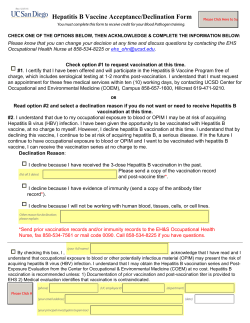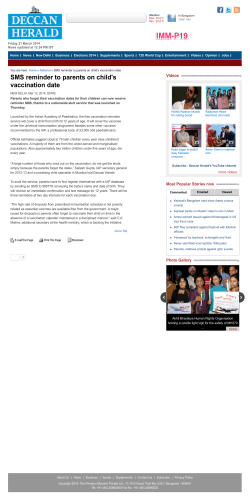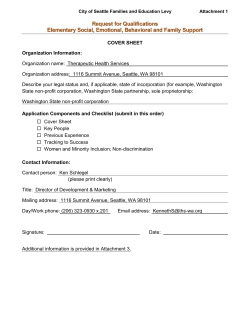
Developing Viral Hepatitis Screening and Prevention Services for
Developing Viral Hepatitis Screening and Prevention Services for American Indians and Alaska Natives at an Urban Chemical Dependency Treatment Facility Ms. Shelly Huffman MPH VHIP Health Educator Seattle Indian Health Board Mei Lin Castor MD, MPH Medical Epidemiologist Urban Indian Health Institute Seattle Indian Health Board M. Castor, M. Taualii, A. Anderson, S. Huffman, A. Park, C. Town, J. Redd, and R. Forquera 2 Geographic Distribution of the AI/AN Population Urban Areas 61% Rural Areas 39% Total AI/AN Population = 4.1 million Percentage of Total U.S. Population = 1.5% Source: U.S. Census Bureau, 2000 Note: AI/AN mixed race 3 Challenges in Describing Urban AI/AN • Lack of data 9No inclusion of urban AI/AN in Indian Health Service statistics 9Non-existent public health surveillance system for urban AI/AN • Poor data quality 9Incomplete data 9Inaccurate data due to errors of racial misclassification; results in consistent underestimates for AI/AN 4 Seattle Indian Health Board • Private, non-profit 501(c)(3) • Community Health Center • Founded in 1970 • Governed by 15-member Board of Directors • Important safety-net healthcare provider in community Pearl Warren Administration Human Resources Fiscal Leschi Clinic Primary Medical Care Dental Care WIC/Nutrition Mental Health Pharmacy Outpatient Chemical Dependency Domestic Violence Community Services Urban Indian Health Institute Research/Epidemiology Programmatic Activities Service to 34 urban Indian health organizations nationwide Thunderbird Treatment Center Residential Chemical Dependency Treatment Satellite Medical Services 6 Thunderbird Treatment Center • Residential chemical dependency treatment facility • Inpatient Treatment: intensive (28 days), recovery (60 days), or long-term (6 months) • Serves 500-600 clients/year • Target population – AI/AN living in Seattle King County region – Adults > 18 years 7 Viral Hepatitis Integration Project at Thunderbird Treatment Center • Fifth year of existence • Provides hepatitis screening/prevention services • Multiple project stakeholders – Thunderbird Treatment Center houses project – Urban Indian Health Institute (UIHI) processes data – Leschi Clinic and UIHI administers project • Project evolution over time – Recent dedicated staff person 8 VHIP Goal and Objectives • Goal: To reduce incidence of viral hepatitis among patient population • Objectives 9 Screen for related risk behaviors 9 Provide education and counseling 9 Provide hepatitis C laboratory testing 9 Provide hepatitis A and B vaccinations 9 Integrate above with patients’ treatment programs 9 Collect information for epidemiology and quality improvement 9 Develop tools for expansion 9 Thunderbird Treatment Center Activities Admission Medical Intake Treatment Program Discharge 10 VHIP Integration: Screening, Vaccination and Testing Admission Medical Intake Risk Factor Screening, Education, and Counseling Vaccination Treatment Program Testing Discharge 11 Risk Factor Screening, Vaccination, and Testing • Risk assessment conducted by VHIP Health Educator/nursing staff − Use of hardcopy instrument • Opportunity for education/counseling − Provision of printed educational materials • Universal vaccination offered for hepatitis A/B – Personal vaccination record for follow up • Universal testing offered for hepatitis C/HIV 12 VHIP Integration: Post-Test Counseling Admission Medical Intake Risk Factor Screening, Education, and Counseling Vaccination Testing Treatment Program Counseling Discharge 13 Post-Test Counseling • Hepatitis and HIV test results – Provided by VHIP Health Educator if negative – Provided by clinical provider if positive • Post-test counseling includes education with focus on a risk reduction plan • Vaccines offered again (if initially declined and appropriate) • Participants with positive results are recommended to receive confirmatory testing and if appropriate, specialty referral 14 VHIP Integration: Group Education Admission Medical Intake Risk Factor Screening, Education, and Counseling Vaccination Testing Group Education Treatment Program Counseling Discharge 15 Group Educational Activities • Monthly Group hepatitis educational session – All clients – Conducted by counselor – Hepatitis C video shown – Pre/post tests administered (recently stopped) • Hepatitis C support group under consideration 16 VHIP Integration: Existing Data Collection Admission Medical Intake Risk Factor Screening, Education, and Counseling Vaccination Testing Group Education Treatment Program Counseling Discharge 17 VHIP Integration: Existing and Proposed Data Collection Admission Medical Intake Group Education Risk Factor Screening, Education, and Counseling Vaccination Testing Treatment Program Counseling Discharge 18 Data Collection, Analysis and Use • Hardcopy data entered into Access database • Processed to ensure data quality – Checking for duplicates – Follow up on missing/incomplete/inaccurate information – Double entry • Analysis for: – Epidemiology – Quality improvement of program 19 VHIP Patient Population • From 9/2002 and 9/2005: 1302 VHIP participants • 78% men • 30% AI/AN 20 VHIP Participant Ages (n= 1302) 450 400 Frequency 350 300 250 200 150 100 50 0 18-25 26-30 31-40 41-50 51+ Age Categories 21 VHIP Participant Race/Ethnicity (n= 1155) Other Hispanic 1% 5% AI/AN 30% White 42% Black 20% Asian/PI 2% 22 Hepatitis A/B Vaccination (n=1302) 49% of VHIP Participants Offered Vaccination (634-641) 79% of Offered gave Consent (502-506) 21% with No Consent (132-135) 88% of Offered were Vaccinated (555-562) 23 2005 Quality Improvement Around Vaccination Increased (n=?) 73% to 98% % of VHIP Participants Offered Vaccination % of Offered Gave Consent Discrepancies decreased % with No Consent 9% to 3% % of Offered Vaccinated Identify Reasons Calculate Hypothetical Immunity levels Other Tracking/follow-up Hepatitis Test Results 24 Hepatitis C Testing (n=1302) 60% of VHIP Participants Offered Testing (784) 76% of Offered gave Consent (595) 24% with No Consent (189) 79% of Offered were Tested (621) 26% of Tested were Positive (163) 74% Negative (458) Post-test Counseling/Risk Reduction Plan Provider Visit 25 2005 Quality Improvement Around Testing (n=?) Increased 62% to 98% % of VHIP Participants Offered Testing % of Offered gave Consent % with No Consent % of Offered were Tested Discrepancies Identify Reasons decreased 24% to 0% Calculate Hypothetical Prevalence % of Tested were Positive Provider Visit Other % Negative QI Post-test Counseling/Risk Reduction Plan Tracking/follow-up 26 Past/Future VHIP Challenges • • • • • Lack of standardization Staffing turnover Poor data quality No feedback of data for quality improvement Measuring effectiveness of education and counseling • Appreciation of data use for epidemiology • Communication between multiple stakeholders • Project sustainability 27 Address Challenges through Standardization Developing Consensus with Stakeholders Development of Uniform Screening Tool Standardization Through: Training of Staff Creation of Standards and Procedures Manual 28 Benefits of Standardization Project Standardization Minimizes Impact of Staff Turnover Ensures Data Quality Prepares for Expansion/Exportation Promotes Sustainability/ Integration 29 Lessons Learned • Identify changes with core program accurately in order to better enhance integration; remain flexible • Standardize as much as possible • Awareness of differing priorities when multiple stakeholders; encourage input from all • Designate dedicated staff person(s) to serve as a bridge between multiple stakeholders • Demonstrate usefulness of data collection • Consider resources necessary for successfully addressing problems identified 30 Thank You 31 Contact Information Urban Indian Health Institute Seattle Indian Health Board P.O. Box 3364 Seattle, WA 98114 Phone: (206) 812-3030 Fax: (206) 812-3044 Email: info@uihi.org Website: www.uihi.org 32
© Copyright 2025





















